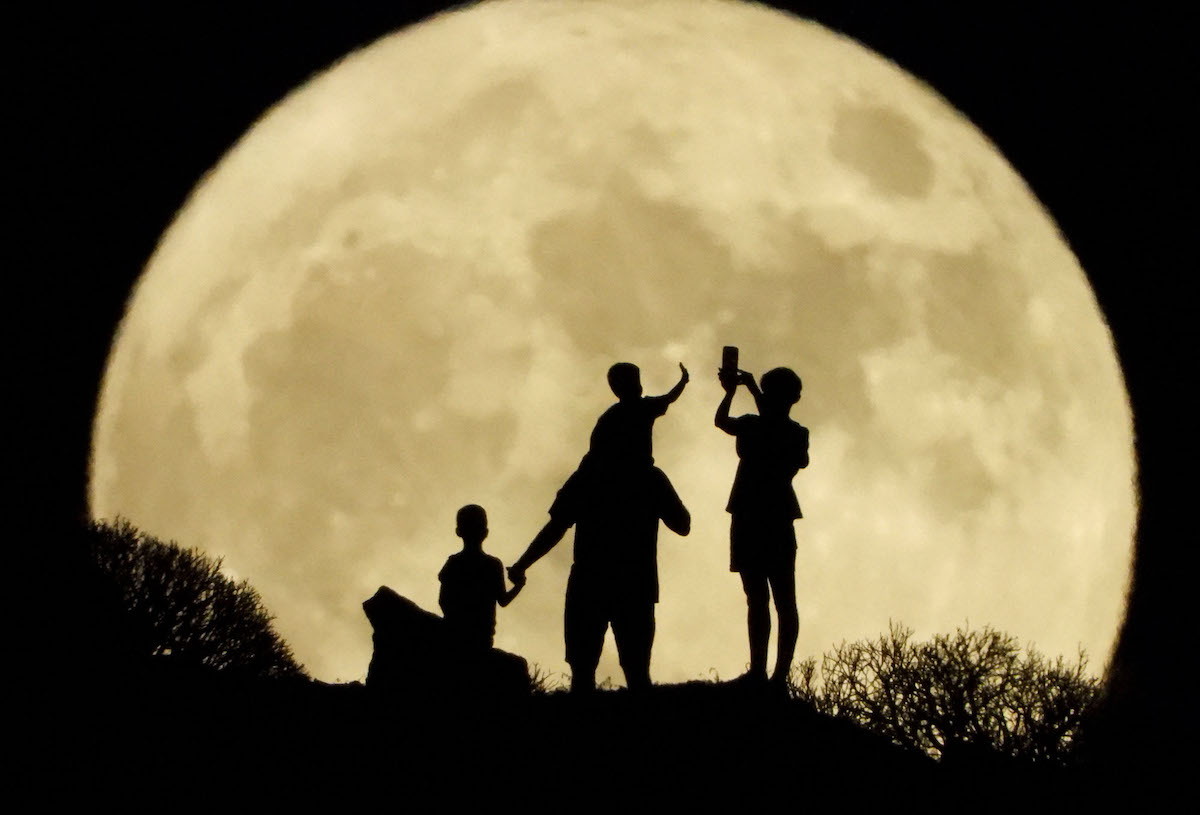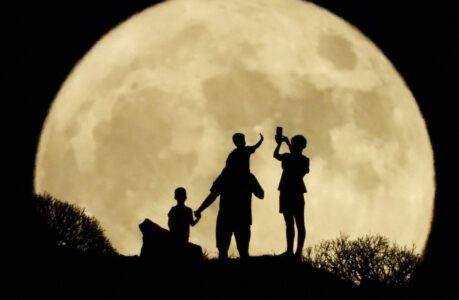Discover the Fascinating Phenomenon of Supermoons and the Forces That Create Them
Introduction: A Cosmic Marvel Unveiled
The night sky has always captivated humanity with its celestial wonders. Among these, the phenomenon of a supermoon stands out as a captivating spectacle that commands our attention. In this article, we will delve deep into the mechanisms that cause a supermoon, a natural event that enchants stargazers and photographers alike. From the celestial dance of Earth, the Moon, and the Sun to the influence of orbits and perigees, we will unravel the secrets behind this awe-inspiring event.
#1. A Supermoon Defined
First and foremost, let’s define what a supermoon is. A supermoon is an astronomical event where the moon appears larger and brighter in the sky than during a typical full moon. It’s a breathtaking occurrence that has fascinated humans for centuries. But what causes this remarkable display in the night sky?
#2. Orbital Mechanics: Earth, Moon, and Sun
At the heart of the supermoon phenomenon lies the complex interplay of the Earth, Moon, and Sun. Understanding the orbits and movements of these celestial bodies is crucial in demystifying the supermoon.
The Earth’s Orbit: Earth orbits the Sun in an elliptical path, which means that the distance between Earth and the Sun varies throughout the year. This variation, known as eccentricity, has a direct impact on the distance between Earth and the Moon.
The Moon’s Orbit: The Moon follows its own elliptical orbit around Earth, with its closest point called perigee and the farthest point termed apogee. These orbital variations are integral to the supermoon phenomenon.
The Sun’s Gravitational Pull: The gravitational force of the Sun plays a significant role in shaping the Moon’s orbit. As the Moon travels around Earth, the Sun’s gravity tugs at it, causing subtle perturbations in its orbit.
#3. The Role of Perigee
Now that we’ve touched upon the Moon’s orbit, let’s explore the concept of perigee, a pivotal factor in the supermoon equation.
Perigee Defined: Perigee is the point in the Moon’s orbit when it is closest to Earth. This is the time when the Moon appears at its largest and brightest in the night sky, creating the stunning visual spectacle we know as a supermoon.
Perigee and Supermoons: When a full moon coincides with the Moon’s perigee, we witness a supermoon. At this moment, the Moon can appear up to 14% larger in diameter and 30% brighter compared to its appearance at apogee, the farthest point from Earth.
#4. The Mechanics of a Supermoon
With a clear understanding of perigee’s role, let’s dive into the mechanics of a supermoon and why it appears larger and brighter in the night sky.
Proximity to Earth: During perigee, the Moon is, on average, about 225,623 miles (363,104 kilometers) away from Earth. This close proximity makes it visually appear much larger than when it is at its farthest point during apogee.
Apparent Size Increase: The Moon’s apparent size is directly proportional to its distance from Earth. As it approaches perigee, it seems larger because it is physically closer to us.
Increased Brightness: The increased proximity during perigee also results in the Moon reflecting more sunlight towards Earth, making it appear significantly brighter.
Perceived Supermoon Effect: The combination of a larger apparent size and increased brightness creates the awe-inspiring supermoon effect that captures the attention of skywatchers.
#5. The Supermoon’s Influence on Tides
Supermoons aren’t just a treat for the eyes; they also have a tangible impact on our planet, particularly on the world’s oceans.
Gravitational Pull: The Moon’s gravitational pull affects Earth’s tides, with the most significant effects occurring during full moons and new moons. Supermoons, being a type of full moon, exert even greater gravitational influence.
Spring Tides: When a supermoon occurs, the alignment of the Earth, Moon, and Sun creates what is known as a “spring tide.” These tides are more extreme, with higher high tides and lower low tides than usual.
Coastal Impacts: Coastal regions experience the most pronounced effects of supermoon-induced spring tides. In some cases, this can lead to coastal flooding and erosion.
#6. The Supermoon’s Cultural Significance
Throughout history, various cultures have attached significance to the moon and its different phases. Supermoons, with their remarkable appearance, have often been the subject of myths, legends, and cultural celebrations.
Cultural Interpretations: Different cultures around the world have their interpretations of supermoons. Some view them as omens, while others see them as symbols of renewal and change.
Supermoon Festivals: In some regions, supermoon events are celebrated with festivals and rituals, where people come together to witness the celestial spectacle and connect with their cultural heritage.
Art and Literature: Supermoons have inspired artists, poets, and writers throughout history. Their beauty and mystique have been immortalized in countless works of art and literature.
#7. Supermoon Variations and Frequency
While the term “supermoon” has become popular in recent years, not all full moons are created equal. There are variations in the degree of “supermoon-ness.”
Supermoon vs. Micro Moon: On the opposite end of the spectrum, we have micro moons, which occur when a full moon coincides with apogee. Micro moons appear smaller and dimmer in the sky.
Frequency: Supermoons are not rare occurrences; they typically happen a few times a year. However, the degree of supermoon-ness varies from one event to another, depending on the Moon’s proximity to Earth during perigee.
Supermoon Calendar: Astronomy enthusiasts and skywatchers eagerly await the release of the supermoon calendar each year to plan their stargazing adventures.
#8. Supermoon Photography Tips
Supermoons offer a fantastic opportunity for photographers to capture the moon’s beauty in all its glory. Here are some tips for capturing stunning supermoon shots.
Equipment: To capture detailed supermoon images, invest in a good quality DSLR or mirrorless camera with a telephoto lens. A sturdy tripod is essential to avoid shaky shots.
Timing: Research the exact time of the supermoon event in your location and plan your shoot accordingly. The moon’s appearance can vary throughout the night.
Location: Choose a location with minimal light pollution and an interesting foreground element, such as a landmark or a natural feature, to add depth to your photographs.
Settings: Experiment with different camera settings, including aperture, shutter speed, and ISO, to achieve the desired exposure and sharpness.
Post-Processing: Don’t forget to post-process your images to enhance their quality. Software like Adobe Lightroom or Photoshop can be invaluable for this purpose.
#9. The Future of Supermoon Watching
As our understanding of celestial mechanics and technology advances, so too does our ability to observe and appreciate supermoons.
Advancements in Technology: Telescopes, cameras, and other astronomical equipment continue to evolve, allowing for even more stunning supermoon observations and photographs.
Public Engagement: Supermoons have the power to captivate the public’s imagination, fostering a deeper interest in astronomy and space exploration.
Scientific Research: Supermoons provide opportunities for scientists to study the moon’s surface and its geological features in greater detail.
Supermoons
In conclusion, the phenomenon of a supermoon is a captivating and awe-inspiring event that results from the intricate interplay of Earth, Moon, and Sun. Understanding the mechanics behind supermoons, such as perigee and the Moon’s orbit, allows us to appreciate the beauty of these celestial occurrences even more. Whether you’re an avid stargazer, a photographer, or simply someone who enjoys gazing at the night sky, a supermoon is a natural spectacle that reminds us of the wonders of our universe. So, the next time a supermoon graces the night sky, don’t miss the opportunity to witness this cosmic marvel in all its glory.
Stay tuned for upcoming supermoon events, and remember to look up at the night sky; you might just catch a glimpse of nature’s own spectacular show.
References
- NASA – Supermoon Science
- EarthSky – What is a Supermoon?
- National Geographic – Supermoon
- Space.com – Supermoon Guide
- The Old Farmer’s Almanac – Supermoons
- The Royal Museums Greenwich – Supermoons
- Astronomy Magazine – How to Photograph a Supermoon
- Sky & Telescope – Imaging the Moon
- Photography Life – How to Photograph the Moon
- CNN – Supermoon Images

